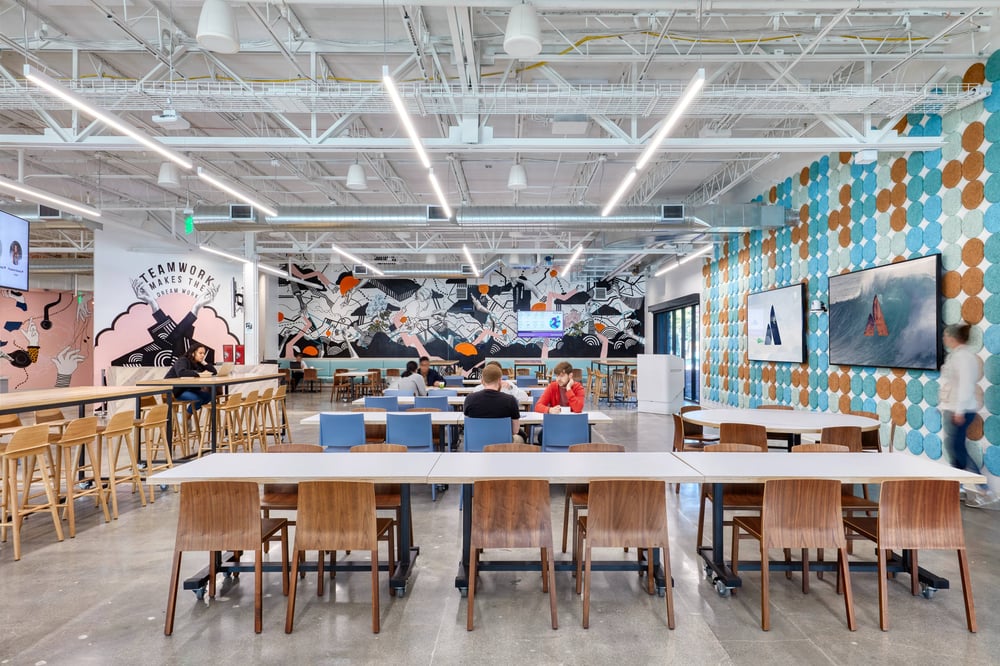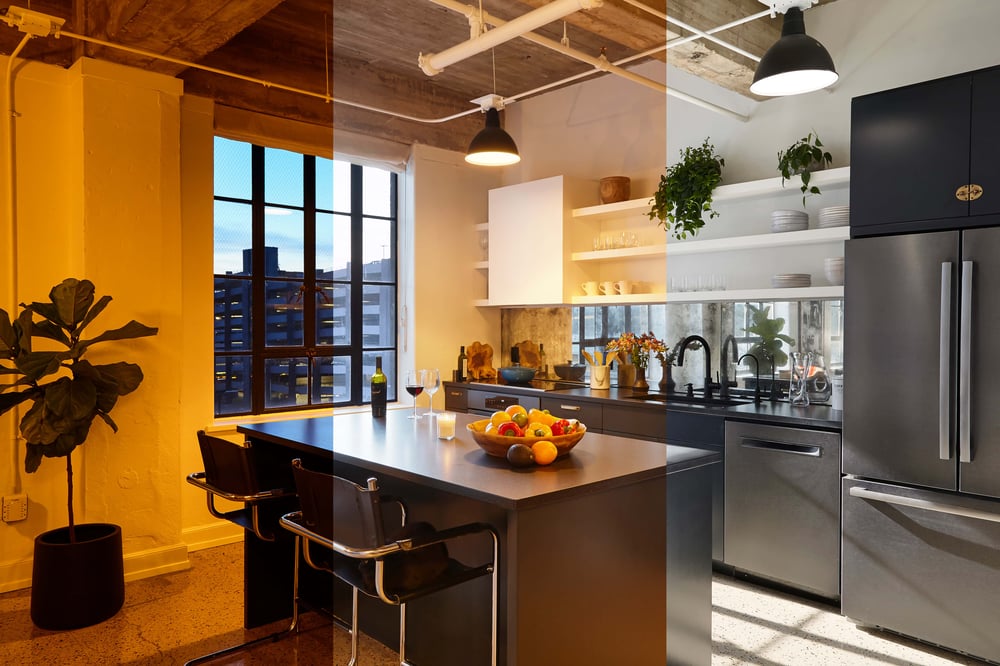In 1665, Isaac Newton did what many of us do after completing our undergraduate studies: He moved back home with his parents. Out of the city and into the English countryside with no proper responsibilities to attend to, the brilliant young scientist was free to follow his curiosities—one of which had always been optics.
One day, Newton poked a hole in his window shade and watched as the sunlight beamed in and across the room. Picking up a prism, he observed that when white light refracted through the glass, it split into a rainbow of colors. Then, by refracting that rainbow through a second prism, the colors united to form white light yet again.
Up until that point, it was thought that white light was pure and that color was somehow a distortion of that purity. Newton’s famous discovery proved the opposite: white light is, in fact, made up of all colors. This revelation led to the understanding that color is a function of light—meaning, an object’s color appearance is directly related to the light shone upon it.
What does this all have to do with tunable white light? In a word, everything.
To understand tunable white light, think about the yellow hue of an incandescent bulb versus the blueness of early LED car headlamps. Both are white light, but the first is on the warmer end of the spectrum, whereas the second is much cooler. The ability to dial in these varying color temperatures is what tunable white light makes possible.
Technically speaking, tunable white light allows you to vary the combination of the colors that comprise white light (a la Newton). The resulting hue is known as the Correlated Color Temperature (CCT). CCT is measured in degrees Kelvin, with a warmer appearance being a lower CCT (generally considered 3000K and below) and a cooler appearance being a higher CCT (above 4000K). On the warm end of the spectrum, you have something like the soft amber of a campfire—and on the cooler end, the bright blue light of an operating room. Neutral white light falls in the middle of the spectrum (around 3000-4000K).
Employing tunable white technology, these parameters can typically be adjusted in real time, using a slider control or a lighting management system.
.png?width=960&name=MicrosoftTeams-image%20(13).png) Easily change CCTs with the Athena touchscreen
Easily change CCTs with the Athena touchscreen
Tunable white light enables designers and users to change the look and feel of objects and interiors to match the moment. While dimmers were the original means of “dialing in” light, tunable white light provides more flexibility to support the right feeling for the right occasion.
One example application is the commercial office. For organizations that want to increase employee satisfaction, tunable white light can create more purpose-centered workspaces. In one area, creatives collaborate on their next big idea under a warm white light designed to promote flow and relaxation. In a meeting room next door, a crisp and invigorating cool white light is energizing a client presentation that demands greater focus and attentiveness.
Tunable white light also allows homeowners to turn their residences into dynamic environments that support their daily routines and enhance overall well-being. Light can be automated to softly rise in the morning, gradually brighten to a midday peak, then dip down to a warm glow in the evening. This sequence aligns with the natural patterns of daylight, Mother Nature’s cues for letting us know when it’s time to wake, work, and rest.
There are installation and maintenance benefits to tunable white light as well. Every specifier and designer knows the pain of getting to the end of a project, only to find the client feels the light isn’t quite right for the space or design. For instance, you specify an elegant marbled white countertop for an all-white kitchen—but once everything is installed, you realize the countertop looks yellowed under the originally specified light. Tunable white light provides "construction tolerance" to lighting designers, and offers the ability to select the perfect CCT to complement the design at any point in the process.
In short, tunable white light allows you to adjust in real time, avoiding costly and time-consuming retrofits and reinstallations. And, when you need to replace a fixture, tunable white ensures you can match the light to the rest of the fixtures without a problem.
Tunable white can be implemented in both wired and wireless configurations.
One significant advantage of a wireless lighting system is simplicity and flexibility. As the name implies, there are no control wires needed. Installation doesn’t require disruptive construction, helping to save on materials and labor costs.
For example, the recently launched Lutron Athena Wireless Node is an in-fixture control that’s smaller than a quarter—and capable of wirelessly controlling both tunable and static white. Designed to fit a standard size fixture knockout, the node is highly flexible and can be specified for linear, downlight, and other form factors. Once specified, the OEM builds the Athena Wireless Node into the fixture, where it can wirelessly communicate with an Athena system, giving you and your commercial customers control at the individual fixture level.
From there, it’s easy to adapt light as spaces evolve. You can change lighting zones and scenes as often as you like, and there’s no rewiring required. Everything is controlled simply and seamlessly right in the software.
Ketra takes this area of innovation even further, going beyond tunable white light to offer a full-spectrum, wireless light source. Using a Ketra fixture, or replacing a standard bulb with a Ketra lamp, you can immediately re-craft your space with high-quality, beautiful light—no need for new switches or wall controls. You can also pair Ketra with wireless wall controls like Pico for easy retrofit. The result is more fixture choice, less wiring hassle, and lower installation costs.
 Tunable white technology is increasingly being used in the workplace to support productivity and well-being
Tunable white technology is increasingly being used in the workplace to support productivity and well-being
As the name implies, with a wired solution your entire lighting system is hardwired, with all involved circuitry leading to one centralized location. In this case, control wires connect to tunable white fixtures, communicating the desired CCT and lighting intensity to the fixture.
While wired is not as flexible as wireless, there are some architectural conditions better suited to wired solutions. If you do have to go the wired route, it’s best to do so during the initial build—and to include a digital control protocol since retrofitting new lighting after the fact can involve significant labor costs.
The award-winning Lutron Athena system can control both Ketra and other tunable white (plus static white) fixtures all in one system—so you can actually combine wired and wireless control types in one solution. You’ll need an LED fixture that’s capable of producing tunable white, and a pair of control wires to run to each fixture. While a wired solution will likely increase the installation cost, you can still achieve much of the flexibility you get with the wireless solution.
While tunable white is an important advancement in lighting technology, Ketra technology represents an exponential leap forward. Whereas tunable white “mixes” just two CCTs, Ketra is capable of producing the full color spectrum, providing an infinitely greater range and more accurate adherence to the black body curve to create beautiful, natural-feeling light.
Built from the ground up with custom power electronics, precision optics, and a proprietary driver chip, Ketra delivers high-quality light that is unrivaled in the marketplace, with notable capabilities including:
From stimulating the body's natural cues to creating optimal workplaces, tunable white can elevate lighting design across a range of clients, projects, and applications. Here are a few ways this technology can transform the environments and experiences you create.
 Tunable white light allows your home to look and feel exactly right for the task at hand—no matter the time of day.
Tunable white light allows your home to look and feel exactly right for the task at hand—no matter the time of day.
It’s been over 350 years since Newton’s post-college prism experiments, and we’re still finding new ways to apply his groundbreaking discoveries. Whether you’re crafting light for a new art exhibit, partnering with a restaurant to develop a new, themed experience, or working with an organization to bring more dynamic lighting to their workspace—both tunable white light and Ketra give you flexibility to dial in a mood that’s just right, every time.
To learn more about Ketra’s award-winning lighting solutions, contact a specialist today.

24/7 Technical Support:
1-844-LUTRON1 (588-7661)
lightingsupport@lutron.com
Customer Service:
Monday-Friday 8am- 5pm EST
1-844-LUTRON1 (588-7661)
The Ketra logo, Ketra, TruBeam, Color Lock, and Calibration360 are trademarks or registered trademarks of Lutron Electronics Co., Inc. in the US and/or other countries.
©2025 Lutron Electronics Co., Inc. All rights reserved.
Get inspired with all the best from Lutron and Ketra: exclusive news, project features, and more.